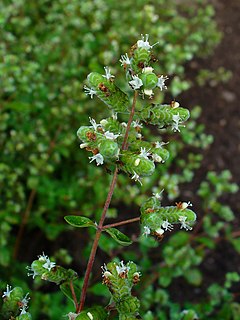
Marjoram is a somewhat cold-sensitive perennial herb or undershrub with sweet pine and citrus flavors. In some Middle Eastern countries, marjoram is synonymous with oregano, and there the names sweet marjoram and knotted marjoram are used to distinguish it from other plants of the genus Origanum. It is also called pot marjoram, although this name is also used for other cultivated species of Origanum.

Oregano is a flowering plant in the mint family (Lamiaceae). It is native to temperate Western and Southwestern Eurasia and the Mediterranean region.

Salvia rosmarinus, commonly known as rosemary, is a woody, perennial herb with fragrant, evergreen, needle-like leaves and white, pink, purple, or blue flowers, native to the Mediterranean region. Until 2017, it was known by the scientific name Rosmarinus officinalis, now a synonym.

Basil, also called great basil, is a culinary herb of the family Lamiaceae (mints).

Monarda didyma, the crimson beebalm, scarlet beebalm, scarlet monarda, Oswego tea, or bergamot, is an aromatic herb in the family Lamiaceae, native to eastern North America from Maine west to Ontario and Minnesota, and south to northern Georgia. Its odor is considered similar to that of the bergamot orange. The scientific name comes from Nicolas Monardes, who described the first American flora in 1569.
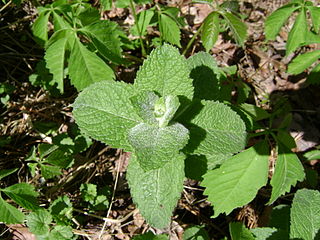
Mentha suaveolens, the apple mint, pineapple mint, woolly mint or round-leafed mint, is a member of the mint family Lamiaceae. It is native to southern and western Europe including the Mediterranean region. It is a herbaceous, upright perennial plant that is most commonly grown as a culinary herb or for ground cover.

Monarda is a genus of flowering plants in the mint family, Lamiaceae. The genus is endemic to North America. Common names include bee balm, horsemint, oswego tea, and bergamot, the latter inspired by the fragrance of the leaves, which is reminiscent of bergamot orange. The genus was named for the Spanish botanist Nicolás Monardes, who wrote a book in 1574 describing plants of the New World.
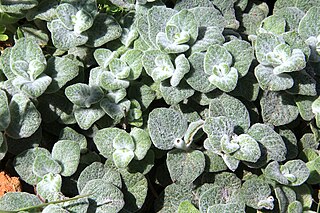
Origanum dictamnus, known in Greek as δίκταμο or in Cretan dialect έρωντας, is a tender perennial plant that grows 20–30 cm high. It is a healing, therapeutic and aromatic plant that grows wild only on the mountainsides and gorges of the Greek island of Crete, Greece. The dittany of Crete is widely used for food flavouring and medicinal purposes, in addition to it featuring as an ornamental plant in gardens. This small, lanate shrub is easily recognised by the distinctive soft, woolly covering of white-grey hair on its stems and round green leaves, giving it a velvety texture. Tiny rose-pink flowers surrounded by brighter purple-pink bracts add an exuberant splash of colour to the plant in summer and autumn. The dittany is classified as vulnerable on the IUCN Red List of Threatened Plant Species 1997.
Plectranthus esculentus, commonly known as the kaffir potato or Livingstone potato, is a species of plant in the dicot family Lamiaceae. It is indigenous to Africa, where it is grown for its edible tubers. It is more difficult to cultivate than Plectranthus rotundifolius, but able to give greater yields. Although the crop is similar to a potato it is from the mint family but it is still quite nutritious and useful. This crop can benefit many subsistence farmers since it is native, easy to grow, growing popularity in the market and quite nutritious.
Carvacrol, or cymophenol, C6H3(CH3)(OH)C3H7, is a monoterpenoid phenol. It has a characteristic pungent, warm odor of oregano.

Plectranthus verticillatus, Swedish ivy, Swedish begonia or whorled plectranthus) is a plant in the family Lamiaceae (Labiatae), genus Plectranthus. Despite its common name, it is not close to the ivy family of the genus Hedera.

Thymus vulgaris is a species of flowering plant in the mint family Lamiaceae, native to southern Europe from the western Mediterranean to southern Italy. Growing to 15–30 cm (6–12 in) tall by 40 cm (16 in) wide, it is a bushy, woody-based evergreen subshrub with small, highly aromatic, grey-green leaves and clusters of purple or pink flowers in early summer.

Monarda fistulosa, the wild bergamot or bee balm, is a wildflower in the mint family (Lamiaceae) widespread and abundant as a native plant in much of North America. This plant, with showy summer-blooming pink to lavender flowers, is often used as a honey plant, medicinal plant, and garden ornamental. The species is quite variable, and several subspecies or varieties have been recognized within it.
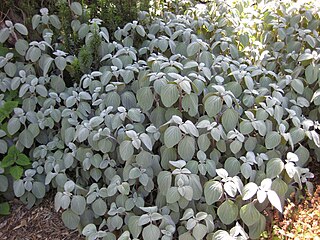
Plectranthus argentatus, common name silver spurflower, is a species of flowering plant in the mint family. It is native to rock outcrops and rainforest in the border region of Queensland and New South Wales, Australia. Growing to 1 m (3 ft) tall and broad, it is a spreading deciduous shrub. The hairy leaves are ovate to broad-ovate, 5–11.5 cm long, 3–5.5 cm wide with crenate margins. The hairs give the plant an overall sage green to silvery colour. The flowers are borne on terminal racemes up to 30 cm (12 in) long, and are bluish white.

Plectranthus scutellarioides, commonly known as coleus, is a species of flowering plant in the family Lamiaceae, native to southeast Asia through to Australia. Typically growing to 60–75 cm (24–30 in) tall and wide, it is a bushy, woody-based evergreen perennial, widely grown for the highly decorative variegated leaves found in cultivated varieties. Another common name is painted nettle, reflecting its relationship to deadnettles, which are in the same family. The synonyms Coleus blumei and Solenostemon scutellarioides are also widely used names for this species.

Lippia graveolens, a species of flowering plant in the verbena family, Verbenaceae, is native to the southwestern United States, Mexico, and Central America as far south as Nicaragua. Common names include Mexican oregano, redbrush lippia, orégano Cimmaron, scented lippia, and scented matgrass. The specific epithet is derived from two Latin words: gravis, meaning "heavy", and oleo, meaning "oil". It is a shrub or small tree, reaching 1–2.7 m (3.3–8.9 ft) in height. Fragrant white or yellowish flowers can be found on the plant throughout the year, especially after rains.

Origanum libanoticum is a species of herbaceous flowering plant in the family Lamiaceae, native to the mountains of Lebanon and Syria.

Plectranthus neochilus, which is colloquially known as lobster bush, fly bush or mosquito bush, is a perennial ground cover with highly fragrant, partially scalloped, ovate leaves and purple blue inflorescent spikes.
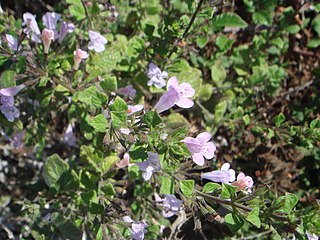
Calamintha sylvatica, the wood calamint or woodland calamint, is a species of herb in the family Lamiaceae. It is native to Western Europe and North Africa, and has been introduced into the United States.
























